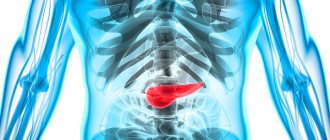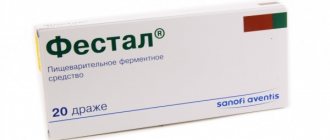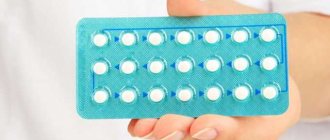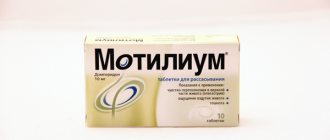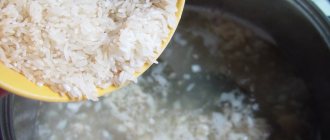Composition of the drug
The main active ingredient is pancreatin. One tablet of 25 action units contains approximately 1200 lipolytic enzymes, 1000 aminolytic, 80 proteolytic.
Pancreatin Forte contains about 4600 units of amylase, 3800 units of lipase and 500 units of protease.
Additional components may include carmine, ponceau 4R, lactose, silicon dioxide, calcium stearate, sterile medical talc, sodium lauryl sulfate, povidone, triethyl citrate, sodium bicarbonate, monohydrate, sodium bicarbonate, indigo carmine, methacrylate copolymer type C. (More detailed article about composition of pancreatin.)
Composition and release form
The drug Pancreatin is produced by many domestic and foreign pharmaceutical companies. The active component of the product is the substance of the same name pancreatin, which is extracted from the pancreas of pigs or cattle.
Depending on the manufacturer, Pancreatin tablets may contain different amounts of the active ingredient with different enzymatic activity:
- Pancreatin OJSC Pharmstandard-Leksredstva contains 125 mg of pancreatin in each tablet with proteolytic activity of 180 FIP units, amylolytic activity - 2800 FIP units and lipolytic activity - 3000 FIP units.
- Each tablet of Pancreatin OJSC "AVVA RUS" contains 100 mg of the active ingredient, and its activity is slightly lower: proteolytic - 130 FIP units, amylolytic - 1700 FIP units and lipolytic - 3000 FIP units.
Therefore, if the pharmacy has several versions of the drug from different manufacturers, you should carefully compare their enzymatic activity before purchasing.
In addition to the active substance, the medicine contains auxiliary substances, the composition and quantity of which also differ depending on the manufacturer.
The tablets are coated on top with an acid-resistant coating, which prevents the inactivation of enzymes in the stomach. This allows the drug to reach the intestines without loss, where the pharmacological effect is manifested.
Pharmacological properties
The drug Pancreatin contains various enzyme fractions of the pancreas, which are capable of breaking down complex carbohydrates, fats, and proteins into simple components. Lipase or steapsin emulsifies complex fats into monoglycerides and saturated fatty acids, converts fat-soluble vitamins into heat and energy for cells. The enzyme promotes the transport of broken down fats into tissues. Amylase breaks down carbohydrates into monosaccharides by breaking the alpha-1,4-glycoside bond in them. Trypsinogen acts on non-dairy proteins, transforming them into essential and essential amino acids.
The drug Pancreatin has a weak analgesic effect due to the feedback inhibition effect of stimulated secretion under the influence of trypsin
It is almost impossible to evaluate the pharmacodynamics of the drug, since each main component acts separately from each other and is destroyed during the breakdown of the food bolus. The maximum concentration of Pancreatin in the duodenum is achieved on average 30 minutes after administration. Excess drug is excreted in unchanged form in feces.
What is pancreatin prescribed for?
The drug is taken when it is necessary to facilitate the digestion of carbohydrates, fats and proteins. The use of pancreatin in diseases of the pancreas compensates for the insufficiency of secretory function (secretion of digestive juice), helps improve the digestion process and helps break down proteins into amino acids, fats into glycerol and fatty acids, starch into dextrins and monosaccharides. In this way, digestion processes are normalized and the functional state of the gastrointestinal tract is improved.
Photo: Frank Flores / Unsplash
Diagnoses and indications when pancreatin or similar drugs are prescribed include:
- Bacterial intestinal infection
- Gastritis
- Gastroduodenitis, acute or chronic
- Dyspepsia (digestive disorder)
- Other types of rosacea
- Rotavirus infection
- Chronic pancreatitis, cholecystopancreatitis
- Simultaneous consumption of hard-to-digest vegetable, fatty and unusual foods;
- Flatulence associated with the above disorders;
- Chewing dysfunction;
- Acceleration of the passage of food in the intestines of a functional nature;
- Preparing for an x-ray or ultrasound of the abdominal organs.
Trypsin in pancreatin suppresses stimulated pancreatic secretion, producing an analgesic effect. The maximum enzymatic activity of the drug is observed 30-45 minutes after oral administration.
Dosage and rules of administration
The drug Pancreatin is used exclusively during meals or immediately after meals for 15 minutes. It is unacceptable to violate the integrity of the smooth protective shell of the drug by breaking or chewing the tablet (the main active component is inactivated in the acidic environment of the stomach). Take Pancreatin only with an alkaline drink (non-carbonated mineral waters like “Borjomi”, “Esentuki” No. 4 or No. 17, “Mirgorodskaya”, “Slavyanskaya alkaline” and others). The volume of water should not be less than 100-150 ml and not exceed 300 ml. In newborns and children up to one year old, it is permissible to replace water with human breast milk or adapted factory milk formulas, with the exception of fermented milk.
International units of action of the drug are converted to the lipase content (thousands) in the drug - 8 (or children's form), 25 and 30.
The frequency of administration and the administered dosage during partial replacement therapy should reflect a person’s daily need for lipase, which for adults is 150,000-200,000 units per day, and for children of various age groups from 50,000 to 100,000 units. With complete replacement therapy, the supply of exogenous lipase varies from 300,000 to 400,000 units per day for any category of patients.
- The average daily dosage for adult patients with partial enzyme replacement should be from 4 to 6 tablets, divided into 2-3 meals at an equal interval of time. When using Pancreatin Forte, use 1-2 tablets for each meal three times a day. In pediatric practice, it is possible to use any form of the drug, with the exception of 3 years of age for Pancreatin Forte.
- For children in the first year of life, the drug is administered only if the form of the drug is preserved. At this age, the dosage is 1 tablet 8 units twice a day.
- From 1 year to 1.5 years – 1 tablet 8 units three times a day
- From 1.5 years to 3 years – 2 tablets of 8 units 2-3 times a day.
- For children over 3 years of age, other forms of the drug can be used, including Pancreatin Forte. The dose of the drug Pancreatin 25 or 30 units varies from 2-3 to 5-6 tablets 3-4 times a day. For the same age category, Pancreatin Forte is used in a dose of 1-3 tablets three times a day at the same time interval.
The literature describes cases of drug administration into the small intestinal stoma. In such cases, the drug should first be crushed and administered in half the dosage of the age norm four times a day.
When taking the drug, it is necessary to take into account the acidity of the gastric contents: in case of hyperacid conditions of gastric juice, it is necessary to double the dosage of Pancreatin, the frequency of dosing remains the same.
The duration of treatment is determined only by the attending physician. The drug can be indicated once before an instrumental study or for several years with an intermittent course of up to 2-4 weeks of withdrawal. For congenital cystic fibrosis, the drug is indicated for lifelong replacement therapy without interruption of treatment for all age groups, including newborns.
Indications
- Cystic fibrosis or multicystic fibrosis of the pancreas;
- Enzymatic deficiency of the gland;
- Chronic pancreatitis of various etiologies in the stage of complete clinical and laboratory remission;
- Diseases of the hepatobiliary tract (chollangitis, cholelithiasis with a single fixed stone, chronic or subacute hepatitis);
- Functional dyspepsia;
- Surgical correction or chemo- and radioirradiation of the gastrointestinal tract in the late recovery period;
- If there is a violation of the mechanical processing of the food bolus (for example, a fracture of the jaw, bulbar disorders, mumps, a decrease in the number of teeth);
- Severe allergic diathesis;
- Dry food and other types of incorrect qualitative and quantitative composition of food products;
- To improve intestinal motility and speedy evacuation of chyme and feces before X-ray or sonographic examinations.
Indications for use
The instructions for Pancreatin allow its use against a wide range of diseases of the gastrointestinal tract. For example, it is prescribed for exocrine insufficiency of the gastrointestinal tract, such as the pancreas, liver, stomach and some parts of the intestine. If problems with enzymes affect the gallbladder, Pancreatin may also be prescribed.
People who suffer from chronic diseases of these organs, such as cystic fibrosis or chronic pancreatitis, often have to buy medicine. Pancreatin tablets can be taken after a number of surgical interventions affecting the stomach or intestines. For example, it is used after gastrectomy, obstruction of the bile ducts or pancreatic ducts, as well as after removal of this gland or part of the stomach.
Other cases also lead to the use of Pancreatin. What does the drug help with:
- Disturbances in the functioning of the gastrointestinal tract caused by prolonged immobilization of a person;
- Late pancreatitis that developed as a result of transplantation;
- Problems in the gastrointestinal tract caused by disorders of chewing function;
- Any chronic pathologies of the biliary tract and liver;
- Poor digestion caused by poor diet, lifestyle and pregnancy;
- Flatulence caused by heavy and fatty foods.
You can take Pancreatin for diarrhea, unless it is caused by infectious processes. Gastrocardiac syndrome, Roemheld syndrome and dyspeptic disorders are also included in the list of indications. Finally, by using such tablets, patients prepare for an X-ray or ultrasound examination of the abdominal organs.
Pancreatin is prescribed for exocrine insufficiency of the gastrointestinal tract, such as the pancreas, liver, stomach and some parts of the intestine.
What else does it help with?
Congenital hereditary enzymatic insufficiency of the pancreas - cystic fibrosis - as a complete replacement therapy.
The natural production of your own enzymes in cystic fibrosis does not exceed 20% of all possible ones. Parietal digestion in the small intestine under the influence of pancreatic enzymes and bile acids, which are fixed on the mucous membrane (brush border of enterocytes). The processes of hydrolysis of chyme in the intestines are the final stage of digestion.
Steapsin or lipase belongs to the group of water-soluble pancreatic enzymes, which takes part in the emulsification of insoluble complex fats into smaller fractions (various fatty acids and monoglycerides). All fat-soluble vitamins, namely A, E and K, are converted into active energy and heat under the action of an enzyme. Steapsin cleaves lipases by disassembling the glycerol backbone in the same lipid substrate. The substance not only affects the qualitative composition of fats, but also promotes their delivery to organs and systems.
Trypsin is formed in pancreatic cells in the inactive fraction - trypsinogen. Under the influence of the enterokinase catalyst, the enzyme is converted into an active form that breaks down proteins into amino acids. Amylase or glycoside hydrolase is capable of breaking down starch into oligo- and monosaccharides.
Currently, there are three subtypes of amylase (alpha, beta and gamma), which are capable of cleaving the alpha-1,4-glycosidic bond of carbohydrates. With replacement therapy, the secretion of the intestine and bronchopulmonary field becomes less viscous and thick, which improves its discharge and also normalizes the digestive processes.
The drug Pancreatin is taken by children for life from the moment of diagnosis. The dosage of the drug for such a pathology should be at the highest possible levels - 70-120 IU per day for lipase conversion, divided into 4-5 doses during feeding. The drug is taken for life. It is possible to vary the dosage in the direction of reducing it when compensation for the condition is achieved.
Maintenance therapy for decreased exocrine gland function
Chronic pancreatitis in remission, functional dyspepsia, cholangitis, cholecystitis and other diseases of the hepatobiliary tract, surgical interventions on the gastrointestinal tract. Improving and normalizing digestive processes due to dry eating, poor nutrition or low-quality food products.
The mechanism of action of the drug Pancreatin is associated with those in congenital malabsorption: the breakdown of essential nutrients (fats, carbohydrates and proteins in the intestine), normalization of the stages of digestion and delivery of the resulting substrates to the organs. Enzymes of intestinal juice should normally neutralize the acidic environment of the chyme that is evacuated from the stomach.
When the quantitative composition of gastric juice decreases, the dosage of the drug is minimal or average (1-2 tablets of 25 or 30 units three times a day). Children are prescribed 8-16 units with the same frequency of administration. The course of therapy is variable: until compensation of the process is achieved and complete restoration of organ function.
As a preliminary preparation of the gastrointestinal tract for x-ray and ultrasound examination methods
Pancreatin breaks down undigested food particles that are retained in the intestines from previous meals. Intestinal motility and chyme evacuation also improve. For these purposes, the drug is used in low dosages two days before the expected scope of research and, if possible, on the day of the manipulation. Adults are prescribed 25-30 units orally 2-3 times a day, children – 8 units three times a day.
Instructions for use
If Pancreatin is needed simply to alleviate a condition that has arisen against the background of unusual or heavy food, then he needs to take one or two tablets. In other cases, you most often need to drink about four capsules, but the dosage depends on the disease.
How to take Pancreatin:
- The daily dose should not exceed 20 thousand units;
- The tablets are drunk with plenty of water during meals without damaging the shell. The drug is effective only in the duodenum, when there is semi-liquid or liquid digested food there along with it;
- Children over six years of age are usually prescribed one tablet per day;
- Children over eight can take two tablets. In case of negative reactions, the dose is reduced;
- The maximum daily dosage for patients with cystic fibrosis is 10,000 units;
- After the desired effect occurs, it is necessary to reduce the amount of the drug;
- The doctor decides how many days you need to take the drug.
With prolonged use, Pancreatin 25 units can lead to a deterioration in the absorption of iron and folate, so during treatment it is necessary to increase the intake of these elements into the body. In general, during therapy you need to follow a diet that includes steamed dishes.
Note. They should not be too cold or hot, they should be at a comfortable temperature.
You need to eat five to six times a day, in small portions. The best consistency for food is semi-liquid, so solid foods should be ground. The same applies to porridges cooked in water, such as semolina, rice, oatmeal and buckwheat. It is useful to drink rosehip decoction or weak tea.
To alleviate the condition after eating unusual or heavy food, it is enough to drink 1 – 2 tablets
Overdose symptoms and side effects
There are two groups of side effects of the drug: common and rare.
- The first includes a violation of the amino acid metabolism of purines and, as a result, hyperuricemia and hyperuricuria with the formation of urolithiasis, stricture or narrowing of natural intestinal bottlenecks (ileocecal flexure, splenic and hepatic angles), discomfort or pain in the epigastric region, heaviness in the abdomen.
- The second group includes skin allergic reactions in the form of itching, burning, and the appearance of various rashes. In rare cases, it is possible to develop an attack of suffocation that resembles bronchial asthma, urticaria or anaphylaxis. In isolated manifestations, the opposite effect from taking the drug is observed: heartburn, increased nausea or vomiting, frequent belching, diarrhea, which is replaced by constipation, increased flatulence.
In case of an overdose of Pancreatin by dose or time (long-term continuous course of therapy), partial or complete (less often) dynamic and strangulation intestinal obstruction may develop. If an emergency condition is suspected, immediate hospitalization of the patient in the surgery department is necessary to correct the restoration of intestinal patency.
Interaction
- Pancreatin is not compatible with ethyl alcohol or its derivatives (more details here).
- The drug improves the adsorption of all antibacterial agents and sulfonamides in the small intestine.
- The drug is not compatible with cymedine, since the latter reduces the therapeutic effect of the enzyme.
- Pancreatin is an active inhibitor of all antithrombotic agents (angiogulants and antiplatelet agents), non-selective inhibitors of neuronal monoamine uptake, antagonists of vikasol, acetylsalicylic group.
- When M-anticholinergics are combined with pancreatic enzymes, the therapeutic effect of the former is enhanced.
- Pancreatin enhances the therapeutic effect of PAS sodium salt or other preparations of sodium salt of aminosalicylic acid.
- Choleretics and cholikinetics enhance the effect of lipase.
- Antihyperacid, cardiotrophic tinctures and other drugs that contain alcohol, magnesium, calcium carbonate and tannin reduce the activity of Pancreatin when used together. Such combinations should be avoided altogether or a break between drug administration should be maintained for at least 4-6 hours.
Contraindications
- viral hepatitis;
- calculous cholecystitis with a large number of stones;
- acute intestinal infections;
- suppurative lesions of the liver and bile ducts;
- massive pancreatic necrosis or autolysis of the gland;
- cirrhosis of the liver;
- dilution of sputum in broncho-obstructive conditions, destructive pneumonia, in bedridden patients;
- polyetiological intestinal obstruction;
- acute pancreatitis or chronic pancreatitis in the phase of clinical and laboratory exacerbation;
- liver failure in the stages of sub- and decompensation;
- obstruction of the bile ducts;
- hepatic coma or kernicterus in newborns;
- hypersensitivity to the components of the drug;
- oncological process in the hepatobiliary tract, pancreas, duodenum and small intestine;
- iron or folate deficiency anemia of moderate or severe severity;
- age up to 3 years when taking Pancreatin Forte;
Contraindications and prohibitions
The drug should absolutely not be taken during an exacerbation of chronic pancreatitis. Also, you should not take tablets if you are particularly sensitive to individual components in their composition. This medicine should not be used for the following diagnoses:
- hepatitis and obstructive jaundice;
- intestinal obstruction;
- empyema of the gallbladder;
- acute pancreatitis;
- cholelithiasis.
During pregnancy and when feeding a baby with breast milk, the medicine is used with extreme caution, having assessed the possible risks and benefits.
Taking Pancreatin for acute pancreatitis, accompanied by severe attacks with pain syndromes, can lead to necrosis of pancreatic tissue. In simple terms, the organ will simply stop functioning and may begin to decompose.
Other reception features
Take with caution in case of diabetes mellitus and polycystic pancreas, cancer of other localizations.
When taking the drug for a long time or when high doses are administered to patients of any age group, monitoring the level of uric acid in the blood and urine is necessary.
In case of hyperacid gastritis, large doses of Pancreatin are required to neutralize the acidic environment of the chyme.
The drug interferes with the absorption and uptake of iron and folic acid by enterocytes.
Use of the drug by children and pregnant women
For health reasons and if it is impossible to correct the resulting condition with nutritional therapy, the drug Pancreatin is approved for use in women during gestation and lactation in the same dosages as in the adult group of patients. The drug is practically unable to penetrate the physiological barriers of the human body. Pancreatin does not have a destructive or toxic effect on the fetus or embryo. Breast milk can contain up to 12% of the main substance when the mother takes the maximum dosage of the enzyme. The drug is widely used in pediatric practice and has no age restrictions in these age groups.
Indications for Pancreatin
It is better to take the product as prescribed by a doctor. Pancreatin may be taken as a one-time measure for the following reasons:
- indigestion, expressed by heaviness;
- increased gas formation;
- overeating fatty foods.
For a course of treatment, the medicine is prescribed by a specialist; enzyme preparations can be indicated for both adults and children. It is not worth choosing on your own which is better - Festal or Pancreatin, or comparing other medications; it is important to follow the prescribed prescription.
In children, the medicine is often prescribed during an intestinal infection, in case of poisoning, or after taking antibiotics - it will help the fragile gland cope with the sharply increased load.
As a means of replacement therapy, Pancreatin tablets help against enzyme deficiency in:
- chronic pancreatitis without exacerbation;
- dyspepsia, flatulence;
- cystic fibrosis;
- non-infectious diarrhea.
The drug is widely used after removal of the pancreas (complete or partial), which is carried out against the background of tissue necrosis in acute pancreatitis and pancreatic cancer.
Enzymes are indicated for children and adults with celiac disease, especially if the diet is not fully followed.
Also, indications for use of the product are a condition after irradiation of the gland or other digestive organs, acute pathologies of the stomach, duodenum. Even for persons without pancreatic pathologies, Pancreatin is prescribed in case of irregular, unhealthy diet, or prolonged immobility of the body, as a measure to prepare for ultrasound or radiography of the peritoneal organs.

